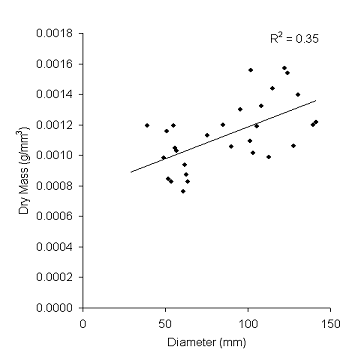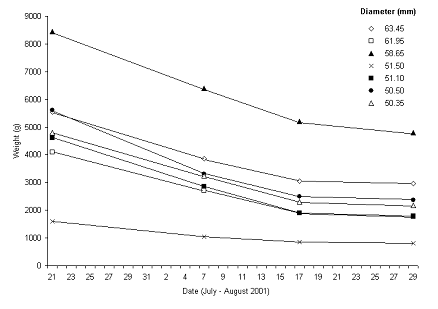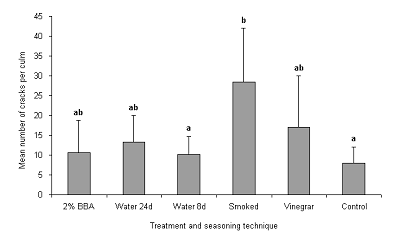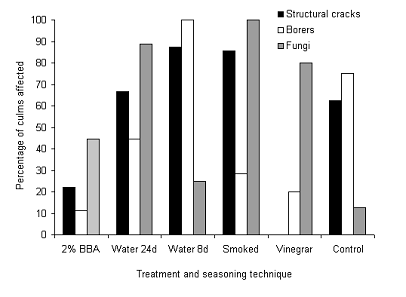Summary, Introduction, Methods, Analysis, Results, Discussion, References, Acknowledgements, Photos, Links
![]()
Results cont.
CULM GROWTH RATE
Of the 37 juvenile culms sampled, 3 died before they could be remeasured. Mean culm growth rate varied significantly between the four transects sampled (ANOVA, F = 9.27, df = 33, P < 0.001, Fig. 7). It was greatest along transect 4, which had a high abundance of mature clumps, where growth rate reached a staggering 18.92 cm/day. Overall mean growth rate was 15.88 ± 1.22 cm/day.

Fig. 7 Mean growth rate of juvenile culms between transects in the core area. Bars represent 95% confidence interval. Means sharing a letter did not differ significantly from one another at the 0.05 level.
CULM BIOMASS
As was expected, there was a very strong significant correlation between the diameter and dry mass of a culm (Pearson, r = 0.56, P < 0.01)(Fig. 8). The R2 value for the relationship showed that 35% of the variation in dry mass could be explained by diameter alone. The equation for the relationship is y = 0.000004x + 0.0008, where y = dry mass in g/mm3, and x = culm diameter in mm.

Fig. 8 The relationship between culm diameter and dry mass. N = 30.
The mean percentage weight loss on drying, for 7 sections of culm over a 40-day period, was 53%, varying from a maximum of 61% to a minimum of 43% (Fig. 9). There was no apparent relationship between the mean diameter of a section of bamboo and percentage weight loss. All sections lost weight at a rate of between 1.11 and 1.52%/day. The relationship suggests that culms will not dry out completely until at least 2 or 3 months have passed.

Fig. 9 Weight loss of 7 sections of bamboo of varying dbh over a 40-day period.
VEGETATIVE PROPAGATION
All parts of the plant tested, except for the branch sections, showed signs of successful germination, although there was great variation within and between treatments and plots. The results of a 2-way ANOVA revealed a significant difference between plant parts (p < 0.01) and between plots (p < 0.05) with respect to their effects on germination success (Table 6). However, there is no evidence to suggest that there is any interaction between these two factors. The mid region of the culm was by far the most successful in all plots, accounting for between 42-100% of shoots. Indeed in plot 3, that closest to the river and with the highest silt and clay content due to frequent inundation, where overall germination success was highest, all sections from the mid region of the culms germinated successfully.
Table 6. Results of a 2-way ANOVA showing the effect of two factors, plant part and plot, on germination success, measured in terms of number of shoots.
|
SS |
df |
F |
P |
|
| Plant part |
62.2 |
4 |
9.3 |
0.00 |
| Plot |
15.8 |
2 |
4.7 |
0.01 |
| Interaction |
17.0 |
8 |
1.3 |
0.28 |
CULM TREATMENT AND SEASONING TECHNIQUE
Although no treatment and seasoning technique was 100% effective against cracking, borers and fungal attack, the degree of impact varied significantly between techniques (Figs. 10, 11). Overall, the best techniques were regarded as "vinegrar" and chemical treatment with BBA, as structurally significant cracks which traversed nodes and borer attack was much lower than other techniques. The worst technique was undoubtedly smoking.

Fig. 10 Mean number of cracks (hairline plus structurally significant) in culms receiving various treatment and seasoning techniques. Bars represent 95% confidence limits. Means sharing a letter did not differ significantly from one another at the 0.05 level.

Fig. 11 Percentage of culms affected by structurally significant cracks, insect borers and fungal attack after having received various treatment and seasoning techniques.
![]()
Summary, Introduction, Methods, Analysis, Results, Discussion, References, Acknowledgements, Photos, Links